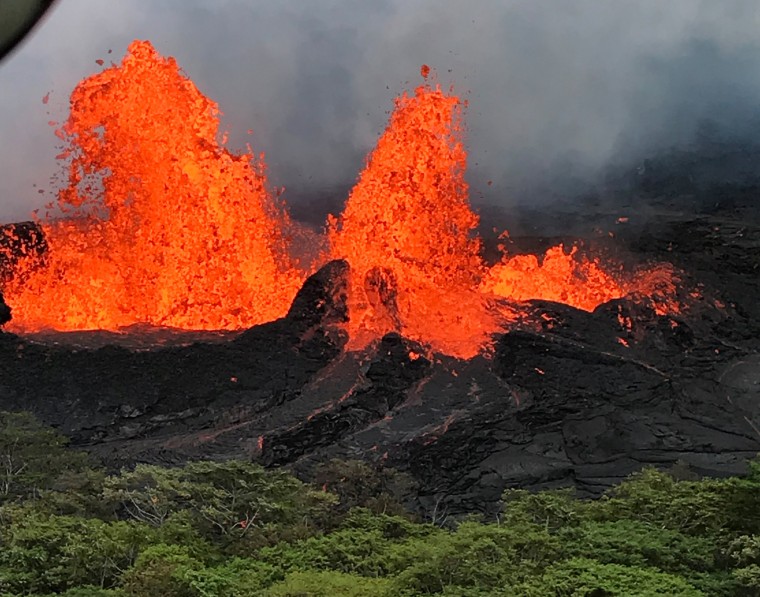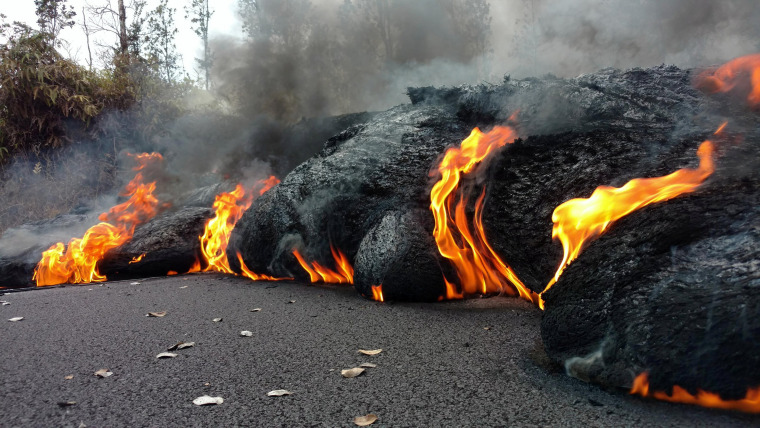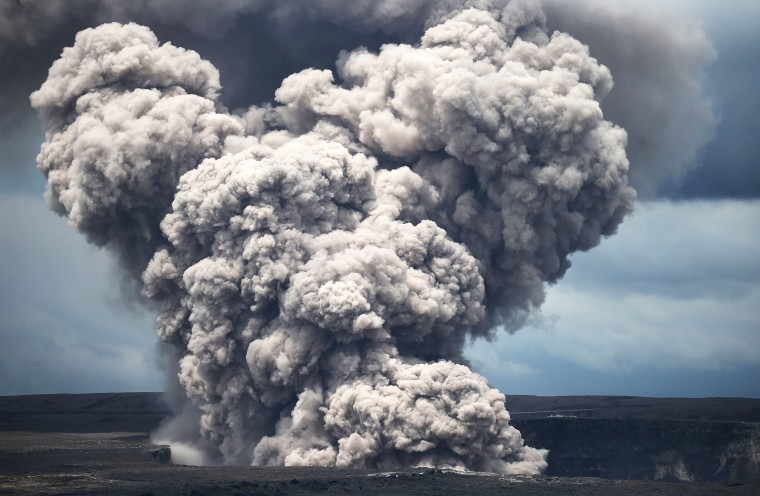Hawaii’s Kilauea volcano has been a hotbed of explosive activity since early May, gushing lava and toxic gases that have destroyed more than 25 homes and forced thousands of area residents to flee. Most recently, Kilauea's lava has begun flowing into the Pacific Ocean, generating plumes of toxic gas and steam called "laze" and shards of volcanic glass as the molten rock hits the seawater.
Kilauea has been continuously erupting since 1983 and is expected to remain a threat in the coming days and weeks. But what has its latest violent episode taught us about volcanic eruptions? How are scientists able to tell when a dormant volcano will rumble to life? And how does predicting volcanic eruptions compare to earthquake prediction and weather forecasting?
To learn the answers to these and other questions, NBC News MACH's Denise Chow spoke with Paul Segall, a professor of geophysics at Stanford University and a noted expert on volcanism. This interview has been edited for clarity and brevity.
MACH: How difficult is it to predict when a volcano is ramping up activity, or when we might see big eruptions like we’ve seen at Kilauea over the past two weeks?
Segall: Most eruptions — but not all — are preceded by precursory activity. We usually see an increase in the number and frequency of earthquakes. We usually see some evidence of ground deformation. Sometimes we see evidence of gas emission — volcanic gases coming out of the ground. It would be great if it was 100 percent of the time, and it would be great if we had more ability to turn that into specific forecasts as to when something might erupt. But we also have times when activity will build up and nothing will happen. There are false alarms.
How many of the world’s volcanoes are monitored for activity?
Very few volcanoes are monitored as extensively as Kilauea. It's one of the most heavily instrumented. It's kind of a test case for the best scenario. It's also a volcano that erupts very frequently, so it's worth putting a lot of resources there. There are many volcanoes that have not a single seismometer on them, so we wouldn't know except from regional earthquake networks, and the earthquakes would have to get pretty big before they'd be picked up by regional networks.

We do now have the ability of monitoring volcano deformation from space with satellite radars. It's a relatively newer technology, and it's growing very rapidly. The advantage of that is you don't have to go out into the field and put an instrument on the ground. You can just image it from space. There are trade-offs, though, because the satellites don't come overhead every day. And in cases where there's a lot of vegetation — say, jungle areas or if there's a lot of snow and ice, it can be more difficult to do. But that's been a real game-changer in terms of being able to, at least in some sense, look at all the volcanoes in the world, or the majority of them, and if signs of activity were measured, then people could go in and actually put instruments on the ground.
What were some of the signs that Kilauea's eruption was about to become more violent?
The first thing that was noticed is what we call inflation — that the summit of the volcano and the areas around Pu'u’ O'o [one of Kilauea's volcanic cones] were swelling, so it was moving upward and outward like a balloon was being pumped up. That means pressure was increasing.

Even though it was erupting, more material was coming into the volcano than was going out, and that was causing the pressure to increase. That's often followed by some kind of breakout somewhere, either enhanced activity or new eruptive vent. That was going on for, I think, several months. And then, immediately preceding the breakouts in the Leilani Estates area [one of the residential areas affected by the latest Kilauea activity], there were earthquakes migrating into that region. There was evidence of ground tilting, so we knew magma was on the move. We didn't yet know whether it would lead to an eruption. But, of course, once you see that, you're not surprised that it starts erupting.
Are volcanoes like earthquakes in the sense that geologists can look at tension building up on a fault and more or less predict when the next big one will occur?
It's different in a number of respects. With earthquakes, for example, in the San Andreas Fault — I worked on that as well — and we can measure strain building up. But we haven't yet seen anything reliably that indicates a change in behavior before an earthquake. Strain will build up and in some cases for rather large earthquakes, it may be 200 years between events or longer, potentially.
In the Pacific Northwest, we think it may be 500 years between the big magnitude 9 [earthquakes], but we see energy building up at a pretty constant rate, and we've been trying very hard to see if we can find something that indicates an acceleration or a change in behavior that leads to the earthquake, other than foreshocks. We haven't seen anything that's consistent and reliable. There are hints here and there, but nothing that we can reliably point to.
Short-term earthquake forecasting is much, much more challenging, whereas volcanic eruptions can't occur unless magma moves into the subsurface. Unlike earthquake prediction — which in terms of short-term prediction is currently not feasible and may never be feasible on a short timescale — volcano prediction is feasible and is common if volcanoes are instrumented. But not all volcanoes are instrumented. You can't do it if you don't have anything to measure.
Is it possible to predict the severity of a volcanic eruption?
There are a couple ways we can get it. One way is just to know what volcanoes have done in the past. If you have a particular volcano, like Kilauea, we have a fairly long historical record. But you can also go back and look at the deposits from past eruptions and see whether they were passive lava flows or they were explosive ash-forming eruptions. We know, for example, that Kilauea has generated explosive ash-forming eruptions in the past, and part of that is from Hawaiian oral tradition, and part of that is from just mapping the geology, mapping the deposits.

The other piece of information would come from the scale of the activity that we measure. Are we measuring earthquakes in a rather small, localized region? Are the earthquakes extending over a big area of the crust that makes it look like there was a very large system involved? So there's some ways that we can get at this, but it's an evolving science to be able to predict the severity and longevity of an eruption once it starts.
How would you compare our ability to predict volcano eruptions to our ability to forecast storms?
Weather forecasting, in my lifetime, has evolved from largely empirically based to much more computationally and physics based. Nowadays, the way weather forecasting works is you take the temperature, pressure, wind speed, and you assimilate all that information into a computational model and then forecast ahead what we would expect to see. The advantage that meteorologists have is that the weather system is visible with satellite observations. You can see storms and you can track them. Volcano forecasting has largely been an empirically based exercise that we see earthquakes building up, we know that earthquakes built up prior to previous eruptions, and if we have volcanoes that erupt rather frequently, like Kilauea or some of the Iceland volcanoes, you can search for patterns and say, "Oh, we've seen this pattern before and it did this before an eruption, so that indicates an eruption is coming."
That doesn't work so well for volcanoes that haven't erupted in historic times. Yet, we do know something about the laws of nature that any system must obey, including volcanic systems. I hope to see a day when we might be able to get more accurate forecasts. It seems like a logical thing to try to parallel how weather forecasting has evolved over the last 50 years.


